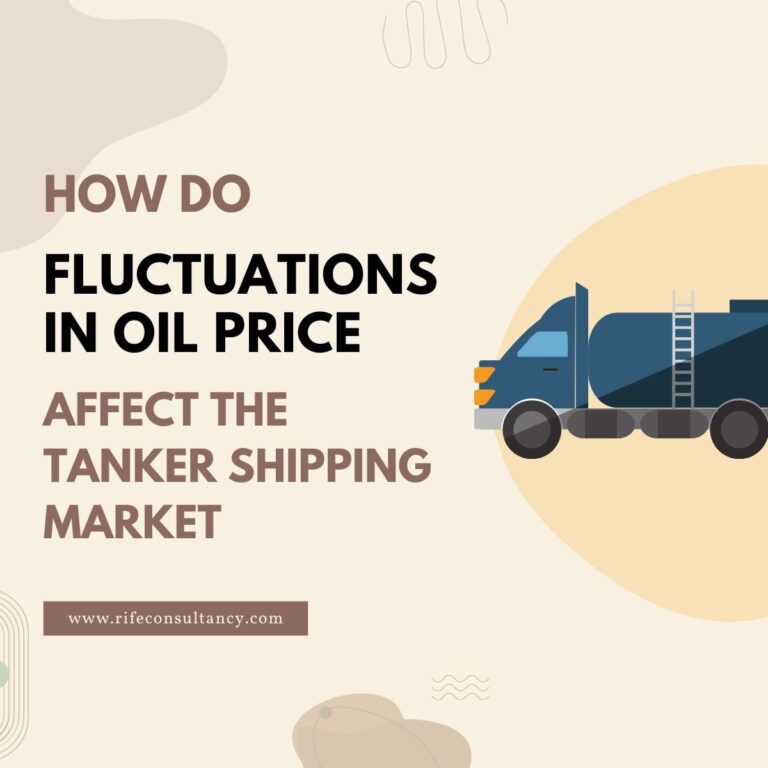
How do Fluctuations in Oil Price Affect the Tanker Shipping Market?
Oil is the most valuable commodity, used in everything from plastics to asphalt to fuel. The oil business is a major economic force, and governments, corporations, investors, and traders all keep a careful eye on fluctuations in oil price.
Oil price volatility has the potential to send shockwaves throughout the global economy. The prices are also influenced by changes in supply and demand. Oil, on the other hand, is not a diamond or caviar—luxury goods with little utility that most people can go without. Because oil is plentiful and in high demand, its price is largely determined by market forces.
Oil prices are influenced by a number of factors, including supply and demand economics. And further, a lot of other things are affected by the fluctuations in oil prices, one of which is the tanker shipping market.
Table of Contents
Shipping is a derived demand
“Shipping is a derived demand. It is not the ships themselves that are in demand, but the goods they carry.”
What exactly does this mean? Derived demand is demand that is dependent on the capacity of an item or service to purchase another good or service. As an example, consider the California Gold Rush. News of gold discoveries in California drew almost half a million people west after an initial discovery in the late 1840s.
These individuals were looking for gold. Nonetheless, it’s sure the person who opted to make picks and shovels instead of prospecting for gold made a lot more money than the vast majority of prospectors. Picks and shovels, you see, were a derived demand that enabled the collection of gold nuggets.
Similarly, shipping is a derived need that enables the efficient, secure, and, in most circumstances, low-cost delivery of an item in demand relative to its worth.
Oil prices and Tanker Market
No single commodity, it is easy to say, has ever had a larger impact on all elements of one’s life than oil. Every movement in the price of oil is closely scrutinized, with everyone wondering where it will go from here.
Fluctuations in the price of oil have an endless number of repercussions, ranging from the cost of energy to heat one’s house to the cost of transportation to get to work, to the cost of the chair you’re reading this in, and so on.
Every barrel of oil has most likely been transported by tanker from the site of extraction to the refinery where it was processed. So, based on all of the foregoing, it’s reasonable to assume that if oil prices rise, so will tanker rates?
As the price of oil rises due to increased demand (i.e. more supply), more people will want ships to transport the oil (i.e. higher derived demand). Let’s assume that supply remains constant and demand rises, resulting in increased pricing. In actuality, though, it is a little more complicated.
Before we get into the implications of oil price variations on tanker rates, it’s necessary to recognize that our situation is a little more complicated. Oil price fluctuations will have not one, but two effects on tankers.
To begin with, it will have an influence on the price of the cargo on board, which is rather obvious yet peculiar to tanker markets. When the price of oil changes, it will also affect the cost of bunker fuel needed to power the ship, which is a typical occurrence in the shipping industry.
So, what fluctuates oil prices?
Oil prices are a result of supply and demand in general. In the case of crude oil, supply refers to barrels removed from the ground in major producers like Saudi Arabia and Russia. Both are members of the OPEC+ alliance, a group of 23 countries whose stated mission is to “coordinate and unify the petroleum policies of its member countries, as well as ensure the stabilization of oil markets, in order to ensure an efficient, economic, and regular supply of petroleum to consumers, a steady income for producers, and a fair return on capital for those investing in the petroleum industry.”
Also Read: Explosion caused by Fumigation: Case Study
We’ll admit it’s a little long-winded, but the concept is a coordinated increase or reduction in supply in response to market circumstances at the moment. Demand for crude oil, on the other hand, comes from refineries, which use crude oil as a feedstock, or raw material, to refine petroleum products that we are more acquainted with, such as jet fuel, gasoline, and diesel. In that sense, crude oil is itself a derived demand!
As a result, the price of crude oil is determined by the supply and demand balance at any particular time. Furthermore, governments will have their own oil inventories, known as strategic reserves, and firms may have built up stockpiles in the event of a major disruption in supply. The price of the aforementioned refined goods will have an influence on crude oil demand, which will, in turn, have a market impact on choices or transactions related to oil supply.
Due to a lack of supply on the market, prices have risen to their highest level in the previous five years.
What fluctuates tanker rates?
This topic has been extensively researched in past academic journals. From maritime economics heavyweights such as Martin Stopford to international organizations such as the UNCTAD, everyone has asked the question: how do oil price changes affect freight prices? However, everyone seems to have a subtly different view regarding the topic.
While a surplus of crude oil on the market may have a negative impact on prices, it will result in more cargoes available for charter and, provided vessel supply remains steady, will be a positive for tanker rates. So, while oil demand drives transportation demand, tanker prices are influenced by the number of ships in a specific location during a certain period of loading, which is much easier to track.
Simply said, shipping demand is not as strongly linked to oil demand as one might think, but rather a function of oil supply and demand, as well as logistical restrictions at the moment (considering onshore and offshore inventories, pipeline flows, etc.) While the supply of ships may be estimated more precisely, the image might be muddled by a variety of market phenomena.
The impact of Bunker fuel prices
To clarify, bunker fuel is any sort of fuel oil used aboard a ship. It comes from crude oil. With the implementation of IMO 2020, bunker fuel and the various types of bunker fuels depending on sulphur content were thrust into the spotlight.
Bunker fuels, which are pitch black and thick and visible while ships are steaming, are a striking visual depiction of the industry’s “dirty little secret,” as some lawmakers have dubbed it. We won’t go into detail about the industry’s issues and challenges, instead, we’ll focus on the fact that being a refined product produced from crude, bunker fuel’s price is greatly influenced by that of the latter.
Bunker fuel costs have long been a major expense for shipowners, accounting for 50 to 75 percent of a vessel’s operational costs. What impact will this have on freight rates? Owners’ operational costs rise in tandem with the price of bunker fuel.
Even while owners will normally try to press for it, this does not necessarily result in increased freight prices. On the other hand, only too often do we see how a fall in crude oil prices and thus bunker prices will lead to overall freight rates in the market declining.
Conclusion
With rising oil costs and the shipping sector coming under more scrutiny for its use of ‘dirty fuels,’ understanding the relationship between oil prices and tanker rates is critical. The answer, like many aspects of shipping market dynamics, is not simple, and several factors must be addressed in order to completely comprehend the link.
We may deduce from the foregoing that the price of oil and freight rates are only partially associated, as only one leg of the journey is linked to oil market fundamentals, whilst oil prices are unrelated to the volume of ship supply and hence the needs of the shipping market.
What is known is the industry’s current reliance on crude oil as its primary cargo and bunker oil as its primary fuel. A future devoid of both calls into question the industry’s very existence. Will oil price variations be significant in the next three decades?
Read more such useful industry insights and news here.
Click here to join our Telegram chanel
You will get information, news, and support related to Merchant Navy.



